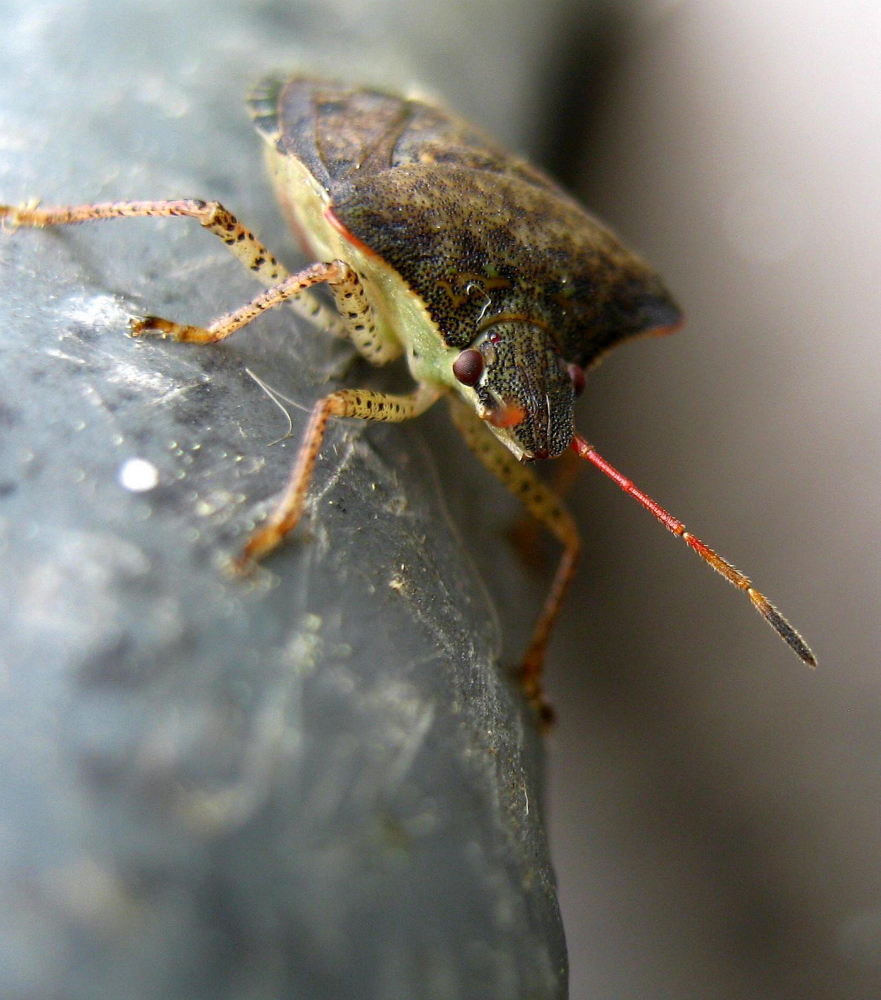We thought the barbarians had finally arrived a few years back, when these long, shield-shaped insects suddenly started appearing everywhere. In the curtains, the kitchen sink, on the deck. Flying around like drunken helicopters. I learned not to surprise them, because they give a little harmless but startling nip. If you swat them, they give off a rancid pine-pitch odor.
So we indeterminately called them stink bugs and sometimes pine bugs for a while, until I scoured through the insect books and discovered they were western conifer seed bugs, cousins of stink bugs. They’re both of the insect order hemiptera and the suborder called true bugs. A lot of true bugs have roughly shield-shaped backs and demonic snouts.
The western conifer seed bugs are a species of leaf-footed bugs, which describes one of their visual characteristics, i.e., leafy looking forelegs. Because we had never noticed them before, we feared we had brought them with us from our recent sojourns in China and South Africa and singlehandedly spawned an ecological disaster of some kind. It turned out they really were aliens — or to use the technical term, invasives — but they were coming from western North America, expanding their range probably as a result of warming climate, according to the reports I read.
Like everything else in this mind-bogglingly diverse biosphere we live in, there are a lot of different leaf-foot species, and they emit a stink when they’re threatened. Stink bugs, of course, do too, and among their equally bewildering array of individual species (about 250 in North America, 5,000 worldwide), some, like the rough stink bug and the black-and-red stink bug, are native Mainers living on your garden.
There is, however, an alien stink bug among us, and it poses the very problem we fantasized about the leaf-foot. It’s the brown marmorated stink bug.
Brown marmorated stink bugs (Halyomorpha halys) — or BMSBs, as the entomologists tag them — were first spotted in North America in Pennsylvania in 1996. The first definitive identification seems to have been made in 1998 and the first official ID in 2001. But the real problem was not what to call them.
They got to Pennsylvania from Asia, probably in shipping material. In China, Japan and Korea they’re regarded as a pest because they eat all kinds of fruit, as well as other plants such as soybeans. But here in North America, they’re more than pests. Since none of our native predators eats them, they proliferate, and in their proliferation, they heavily damage or even wipe out peach, pear and apple orchards, gouging into and “catfacing” the fruit. They’ve been found eating blackberries, corn, soybeans, tomatoes, lima beans and green peppers, too. They don’t bite people, which is a plus, but they might get into your warm house for the winter.
When stink bugs feel threatened, the adults discharge a chemical through slits from a gland on the thorax, an apparently effective deterrent to predators such as lizards and birds. One entomologist witnessed a stink bug actually spray a spider. The spider darted away, puked and then set to work cleaning its mouth parts (not an unusual activity after a meal for some spiders).
The stink results from chemical combinations involving aldehydes and esters, which happen to be used by humans in synthetic combinations to create the scent of coriander (or so I’ve read). One naturalist writer describes stink bugs’ aeroallergenic odor as skunky, another as rancid almond, though I’ve never smelled it myself.
Some researchers, trying to experience the effect firsthand, dabbed stink bug juice in their own mouths. They experienced “a burning sensation and chemical taste that lingered for up to 20 minutes … followed by a slight localized numbness of the tongue, which lasted 1-2 hours.” So maybe the birds, who would not have been deterred by the smell because many lack an olfactory sense, just didn’t like the taste.
I took a picture on my deck last summer of what I thought must be a BMSB, sort of the same way I was sure the western conifer seed bugs were stink bugs. It turned out, when I got a real entomologist to look at my photos, to be just a garden variety stink bug with a few brown-marmorated features.
The nearest established population of BMSBs is in New Hampshire, according to the Maine Department of Agriculture’s Exotic Berry Pest Survey for 2015, but two fugitives have been captured here riding in vehicles from Maryland. Another was detained trying to get onto Prince Edward Island on a truck this spring. If you think you’ve seen one, you might want to let the insect authorities know. It’s a true bug threat, not a barbarian of your fantasies.
Dana Wilde lives in Troy. His writings on the curiosities of his backyard are collected in “The Other End of the Driveway,” and he is a contributor to “Pluto: New Horizons for a Lost Horizon” available from North Atlantic Books. You can contact him at naturalist1@dwildepress.net. Backyard Naturalist appears the second and fourth Thursdays each month.
Send questions/comments to the editors.




Success. Please wait for the page to reload. If the page does not reload within 5 seconds, please refresh the page.
Enter your email and password to access comments.
Hi, to comment on stories you must . This profile is in addition to your subscription and website login.
Already have a commenting profile? .
Invalid username/password.
Please check your email to confirm and complete your registration.
Only subscribers are eligible to post comments. Please subscribe or login first for digital access. Here’s why.
Use the form below to reset your password. When you've submitted your account email, we will send an email with a reset code.